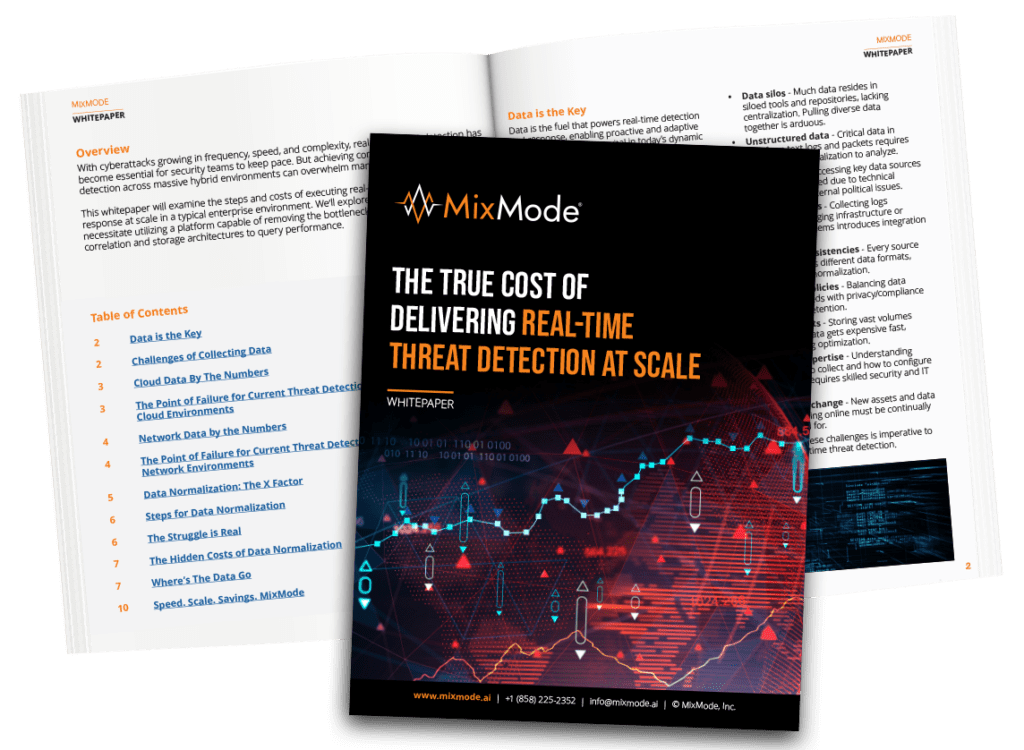Organizations continue to face an uphill battle in maintaining their security posture and defending their digital assets against sophisticated cyber attacks. Traditional security measures, such as legacy rules-based and signature-based solutions, are struggling to keep pace with the scale and complexity of modern threats.
The Need for Real-Time Threat Detection at Scale
Cyber attacks are becoming increasingly sophisticated, with threat actors constantly evolving tactics to bypass traditional defenses. Organizations need to be able to detect and respond to threats in real-time to minimize the potential damage. Real-time threat detection allows organizations to identify and mitigate suspicious activity and attacks as they happen, reducing the dwell time of threats within their networks and minimizing the impact on their operations.
The Struggle to Gain a Clear Picture of the Entire Attack Surface
One of an organization’s most prominent challenges is comprehensively understanding its entire attack surface. The attack surface has expanded exponentially with the proliferation of cloud services, IoT devices, and remote work environments. Many organizations struggle to keep track of all the assets, cloud environments, applications, and endpoints within their network, making it difficult to identify potential vulnerabilities and threats.
Legacy Rules-Based Solutions: Unable to Scale
Legacy cybersecurity solutions, which rely on predefined or custom rules and signatures, are ill-equipped to handle the scale and complexity of modern cyber threats. These solutions often require manual intervention and constant updates to stay effective, making them time-consuming and resource-intensive. As the attack surface expands, legacy solutions struggle to keep up, leading to gaps in coverage and increased vulnerability to attacks.
The Limitations of Signature-Based Threat Detection
Signature-based threat detection, a common approach used by legacy solutions, relies on known patterns and signatures of previously identified security threats. However, this approach has significant limitations in providing advanced threat detection. Bad actors are constantly developing new attack techniques and zero-day vulnerabilities that lack specific signatures. As a result, signature-based solutions can miss up to 80 percent of attacks, exposing organizations to unknown and emerging threats.
The Advantages of Doing Real-Time Threat Detection at Scale:
- Rapid Detection and Response: Real-time threat detection enables organizations to identify and respond to attacks as they occur, minimizing the potential damage and reducing the time to remediation. By leveraging advanced technologies such as AI and machine learning, organizations can analyze vast amounts of data for anomaly detection across cloud, network and identity to identify potential threats often missed by traditional methods.
- Comprehensive Visibility: Real-time threat detection at scale gives organizations a holistic view of their entire attack surface. Organizations can gain a clear understanding of their assets and potential vulnerabilities by continuously monitoring network traffic, endpoint devices, and applications. This visibility allows for proactive threat hunting and identifying potential weak points before they can be exploited.
- Adaptive and Intelligent Defense: Real-time threat detection solutions powered by AI and machine learning can adapt and evolve to new and emerging threats. These solutions can include analysis capabilities to learn from new attack patterns and continuously improve their detection algorithms without manual intervention or constant updates. This adaptive approach ensures organizations stay ahead of cybercriminals to minimize potential impact and effectively defend against evolving threats.
- Reduced False Positives: Real-time threat detection solutions leverage advanced analysis and behavioral analytics to reduce false positives. By understanding the context and intent behind network activities, these solutions can differentiate between normal and abnormal behavior, minimizing unnecessary alerts and allowing security teams to focus on genuine threats.

The Challenges of Implementing Real-time Threat Detection
Performing real-time threat detection can be challenging and costly for many organizations due to several reasons:
- Lack of Resources: Real-time threat detection requires significant resources, including skilled cybersecurity professionals, advanced technologies, and robust infrastructure. Many organizations lack the budget or expertise to invest in these resources, making implementing and maintaining effective real-time threat detection capabilities challenging.
- Complexity of the Threat Landscape: The modern threat landscape is complex and constantly evolving. Bad actors employ sophisticated techniques, such as polymorphic malware, zero-day exploits, AI, and social engineering, to bypass traditional security measures. Detecting and responding to known and unknown threats in real-time requires advanced technologies and continuous monitoring, which can be challenging for organizations to implement and manage effectively.
- Lack of Visibility: Organizations often struggle to gain comprehensive visibility into their network and systems. With the increasing adoption of cloud services, IoT devices, and remote work environments, the attack surface has expanded, making it difficult to monitor and detect threats across all endpoints and applications. Limited visibility can lead to blind spots, allowing threats to go undetected and causing delays in response and remediation.
- Alert Fatigue: Some security products generate a large volume of alerts and notifications. Security teams can become overwhelmed by the sheer number of alerts, leading to alert fatigue and potentially missing critical indicators of compromise. It can be challenging for organizations to effectively prioritize and investigate alerts in real-time, resulting in delayed or inadequate response capabilities to potential threats.
- Lack of Integration and Automation: Real-time monitoring requires seamless integration and automation across various security systems and tools. However, many organizations struggle with integrating disparate security solutions, leading to fragmented visibility and inefficient workflows. Manual processes and lack of automation can slow response times and hinder the ability to detect and mitigate threats in real-time.
- Skill Gap: The cybersecurity skills gap is a significant challenge for organizations. Finding and retaining skilled cybersecurity professionals who can effectively perform real-time threat detection is a constant struggle. The industry’s talent shortage can limit an organization’s ability to implement and manage real-time threat detection capabilities.
- Compliance and Regulatory Requirements: Organizations operating in regulated industries face additional challenges in real-time threat detection. Compliance requirements, such as data privacy regulations and industry-specific standards, impose strict security measures and reporting obligations. Meeting these requirements while maintaining real-time threat detection capabilities can be complex and resource-intensive.

Real-time threat detection is crucial for organizations to effectively maintain their security posture and gain enhanced visibility to defend against ever-evolving cyber threats. However, many organizations face challenges implementing and maintaining effective threat detection capabilities. Legacy rules-based solutions and signature-based threat detection are no longer sufficient to protect against malicious activity. And doing it alone can be costly.
Overcoming these challenges requires adequate resources, advanced technologies, comprehensive visibility, automation, skilled professionals, and a proactive approach to cybersecurity.
So, what’s the true cost of real-time threat detection? And how do you find a solution that truly does real-time threat detection at scale?
Other MixMode Articles You Might Like
Insights and Trends from Gartner Emerging Tech Impact Radar: Security
Buyers Guide for AI Threat Detection and Response
Utilizing Artificial Intelligence Effectively in Cybersecurity
Bridging the Gaps: Why ITDR is the Missing Link in Identity Protection
Visibility is Not Enough to Protect Organizations from Identity Threats


